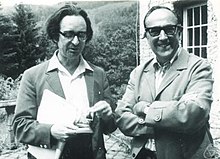Frank Harary | |
|---|---|
 Frank Harary (left) and Klaus Wagner in Oberwolfach, 1972 | |
| Born | March 11, 1921 New York City, New York, US |
| Died | January 4, 2005 (aged 83) |
| Alma mater | Brooklyn College University of California, Berkeley |
| Known for | Goldner–Harary graph Harary's generalized tic-tac-toe |
| Scientific career | |
| Fields | Mathematics |
| Institutions | University of Michigan New Mexico State University |
| Doctoral advisor | Alfred L. Foster |
Frank Harary (March 11, 1921 – January 4, 2005) was an American mathematician, who specialized in graph theory. He was widely recognized as one of the "fathers" of modern graph theory.[1] Harary was a master of clear exposition and, together with his many doctoral students, he standardized the terminology of graphs. He broadened the reach of this field to include physics, psychology, sociology, and even anthropology. Gifted with a keen sense of humor, Harary challenged and entertained audiences at all levels of mathematical sophistication. A particular trick he employed was to turn theorems into games—for instance, students would try to add red edges to a graph on six vertices in order to create a red triangle, while another group of students tried to add edges to create a blue triangle (and each edge of the graph had to be either blue or red). Because of the theorem on friends and strangers, one team or the other would have to win.